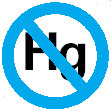Hidden and dangerous We were aware of the dangers of mercury pollution because we had heard of Minamata. But it seemed so distant. We knew about the science of mercury but it never actually threatened us. To be honest, we were illiterate about the subject. That is, till we rated the chlor-alkali sector under our Green Rating Project (GRP). GRP, an endeavour of the Centre for Science and Environment (CSE), rates Indian industries on their environmental performance and then discloses the information to the public. It follows a detailed rating process and relies on voluntary disclosure of facts from companies. During the rating of the chlor-alkali sector, we were horrified to learn that more than 90 per cent of the mercury used in the industrial process literally vanished into thin air. No mercury is actually consumed, so whatever is used has to be discharged with effluents, wastes, air emissions or has to be present in the products. We asked the companies for a mercury use balance sheet. We were thankful that they obliged, but they too had no idea where this mercury was going.
We tested the soil, water, effluents and sludge within and outside the mercury cell plants. We found that mercury was present in the effluent of each company at levels slightly above or below regulatory norms. But to our surprise, we found similar levels of mercury in the wastewater of a spinning mill that only used caustic soda and diluted sulphuric acid from a mercury cell plant. This confirmed our fear that a high amount of mercury escapes with products and by-products of mercury cell plants.
We also found that the amount of mercury in the soil within the premises of chlor-alkali plants was consistently less than that more than a kilometre away. We concluded that mercury is not likely to be found right next to the place where it is used. Instead, it will evaporate and travel far and wide and get deposited elsewhere. Mercury is an invisible pollutant and threatens public health far away from the place of actual use. Mercury is, therefore, too dangerous a substance to be allowed to move freely in the country. We need to look at mercury pollution from an entirely different perspective than the one with which we view general industrial pollution. For instance, regulating mercury in wastewater is useless. We need to monitor the total mercury consumed in the process. After we disclosed our findings, we received mixed responses: A muted response from the government and industry and a more shocked response from the public. We wrote to the government asking for economic instruments to facilitate the switchover of mercury-based chlor-alkali plants to membrane-based plants. The finance minister promptly announced import duty reductions on membrane technology. The Ministry of Environment and Forests (MoEF) also decided to look afresh at the chlor-alkali industry. But so far we have not heard of any regulatory initiative, except for a new voluntary norm to reduce mercury consumption. Industry is now trying to push the MoEF to agree to a 2020 deadline for phasing out mercury cell technology. From our perspective, that would be highly irresponsible. The industry is willing to risk public health for a mere 10–12 mercury cell plants, most of which have exceeded their economic life. The economics also do not make sense. Mercury cell plants consume more electricity and are inefficient. In this supplement of the Industry and Environment Unit of CSE, we have looked at mercury pollution and its threat to public health. We have looked at our regulations and have identified the loopholes. We have also explored ways to reduce the risk. We hope to hear from you on our results. Chandra Bhushan,
|
|||
| |

 We spoke to experts and the mystery was
unveiled to us. We were told that mercury is a highly mobile substance. It continuously
escapes in traces, even from sludge buried deep within "secure" landfills, and
companies have no facilities to monitor this escape. We were advised to do some tests.
We spoke to experts and the mystery was
unveiled to us. We were told that mercury is a highly mobile substance. It continuously
escapes in traces, even from sludge buried deep within "secure" landfills, and
companies have no facilities to monitor this escape. We were advised to do some tests.
